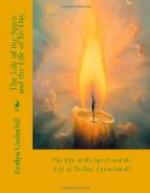of their physical and mental behaviour is bound up
with this persistent influence of the past”:
and most actions and responses “can only be
brought under causal laws by including past occurrences
in the history of the organism as part of the causes
of the present response."[127] The phenomena of apperception,
in fact, form only one aspect of a general law.
As that which we have perceived conditions what we
can now perceive, so that which we have done conditions
what we shall do. It therefore appears that in
spite of angry youthful revolts or mature sophistications,
early religious training, and especially repeated
religious
acts, are likely to influence the
whole of our future lives. Though all they meant
to us seems dead or unreal, they have retreated to
the dark background of consciousness and there live
on. The tendency which they have given persists;
we never get away from them. A church may often
seem to lose her children, as human parents do; but
in spite of themselves they retain her invisible seal,
and are her children still. In nearly all conversions
in middle life, or dramatic returns from scepticism
to traditional belief, a large, part is undoubtedly
played by forgotten childish memories and early religious
discipline, surging up and contributing their part
to the self’s new apprehensions of Reality.
If, then, the cultus did nothing else, it would do
these two highly important things. It would influence
our whole present attitude by its suggestions, and
our whole future attitude through unconscious memory
of the acts which it demands. But it does more
than this. It has as perhaps its greatest function
the providing of a concrete artistic expression for
our spiritual perceptions, adorations and desires.
It links the visible with the invisible, by translating
transcendent fact into symbolic and even sensuous
terms. And for this reason men, having bodies
no less surely than spirits, can never afford wholly
to dispense with it. Hasty transcendentalists
often forget this; and set us spiritual standards
to which the race, so long as it is anchored to this
planet and to the physical order, cannot conform.
A convert from agnosticism with whom I was acquainted,
was once receiving religious instruction from a devout
and simple-minded nun. They were discussing the
story of the Annunciation, which presented some difficulties
to her. At last she said to the nun, “Well,
anyhow, I suppose that one is not obliged to believe
that the Blessed Virgin was visited by a solid angel,
dressed in a white robe?” To this the nun replied
doubtfully, “No, dear, perhaps not. But
still, you know, he would have to wear something.”




